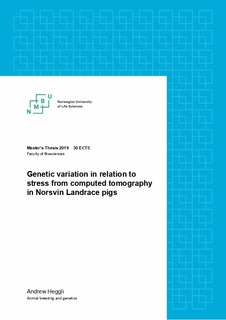Genetic variation in relation to stress from computed tomography in Norsvin Landrace pigs
| dc.contributor.advisor | Berg, Peer | |
| dc.contributor.advisor | Karlsson-Drangsholt, Tale Marie | |
| dc.contributor.author | Heggli, Andrew | |
| dc.date.accessioned | 2019-12-05T10:52:24Z | |
| dc.date.available | 2019-12-05T10:52:24Z | |
| dc.date.issued | 2019 | |
| dc.identifier.uri | http://hdl.handle.net/11250/2631931 | |
| dc.description.abstract | Resilience towards stress is an important trait as it has implications for animal welfare, and can reduce labour costs. Though some traits included in breeding programs cover disease resilience, general resilience towards stress has yet to be included. As selective breeding has improved many other traits, it is feasible that it can be used to improve resilience towards stress. For a trait to be viable for selection it needs to have enough genetic variance and a high enough heritability to produce a response to selection. The aims of this thesis were therefore: 1. to develop novel phenotypes that can measure sensitivity to stress in pigs based on variation in feed intake (FI) data after computed tomography (CT-scanning) and potentially be used in selective breeding to increase stress resilience 2. to determine heritabilities, genetic variation and genetic correlations between the novel phenotypes and production traits such as growth. Feed intake data from the Norsvin Delta testing station in Hamar, Norway was used to create novel phenotypes based on within boar regressions. There were two groups of novel phenotypes based on how they measured stress resilience; number of days in FI deficit post CT-scanning, and total accumulated deficit for the number of days in FI deficit post CT-scanning. Number of days in deficit measured the length of time boars were affected by stress from CT-scanning, and total deficit measured the amount boar FI was affected by stress from CT-scanning. Different methods of data treatment were applied to the two measures of resilience to find the method of measuring resilience that had the highest heritability and genetic variance, and would therefore be best suited to use in a breeding program. The best suited novel phenotypes were also used in multivariate analyses that included OCD score as a health trait, and standardised growth from 40 to 120 kg and standardised FI from 40 to 120 kg as production traits to ensure that they were separate traits from the novel phenotypes. | nb_NO |
| dc.language.iso | eng | nb_NO |
| dc.publisher | Norwegian University of Life Sciences, Ås | nb_NO |
| dc.rights | Attribution-NonCommercial-NoDerivatives 4.0 Internasjonal | * |
| dc.rights.uri | http://creativecommons.org/licenses/by-nc-nd/4.0/deed.no | * |
| dc.subject | Stress resilience | nb_NO |
| dc.subject | Stress genetic variation | nb_NO |
| dc.subject | Pigs stress | nb_NO |
| dc.subject | Computed tomography pigs | nb_NO |
| dc.subject | Stress genetic variance boars | nb_NO |
| dc.title | Genetic variation in relation to stress from computed tomography in Norsvin Landrace pigs | nb_NO |
| dc.type | Master thesis | nb_NO |
| dc.subject.nsi | VDP::Matematikk og Naturvitenskap: 400::Basale biofag: 470 | nb_NO |
| dc.source.pagenumber | 29 | nb_NO |
| dc.description.localcode | M-HV | nb_NO |
Tilhørende fil(er)
Denne innførselen finnes i følgende samling(er)
-
Master’s theses (BioVit) [348]

